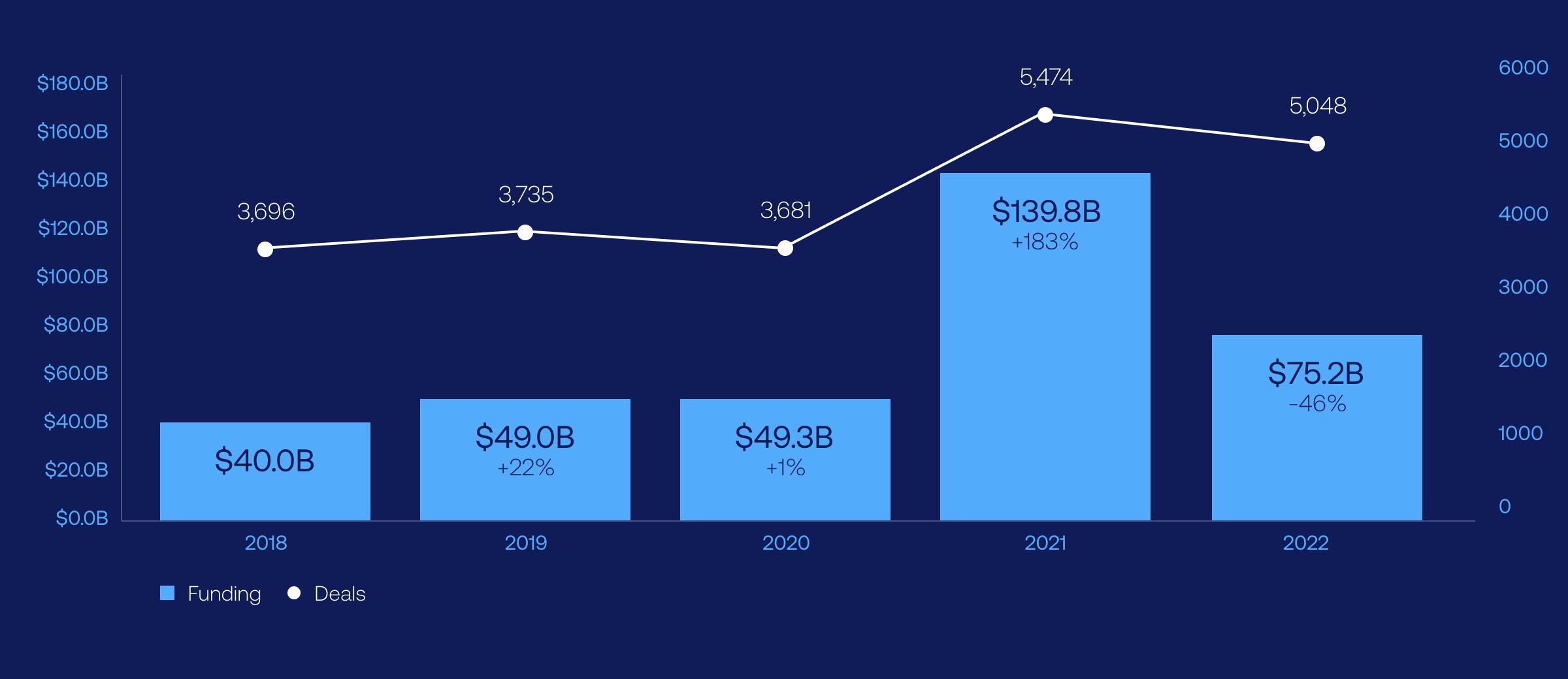
Fintech unicorns: Facts and figures

By any measure, 2021 was a banner year for venture capital and the unicorn herd: 591 new unicorns were born. Now we’re seeing that likely wasn’t an indicator of a new trend, but was more of an outlier or even an anomaly. In 2022, optimism in the economy was wrecked by a parade of undesirable events — rising inflation and interest rates, ongoing global supply chain problems, the Russia-Ukraine war — that dramatically changed the market conditions and generated concerns about a looming recession.
Clearly these game-changing events slowed the pace of investment, and the business world watched the first waves of tech worker layoffs with horror. Then to make matters worse, FTX collapsed and the entire crypto industry quavered.
Moreover, to the consternation of ambitious startup founders worldwide, both the number of unicorns born and unicorn valuations took a serious hit in 2022.
But according to Andrew Haines, our global head of fintech, that’s not necessarily a bad thing.
“There’s a pullback in enthusiasm for reaching unicorn status, and the downturn is a reflection of free money being gone,” he says. “All the fluff has come out of the market. What’s really happening is a healthy correction of expectations.”
And yet . . . when you look closely at 2022’s data with respect to fintech unicorns, there is in fact some good news: comparing by sector, fintech remains the darling.
Funding for fintech startups
2021 was a remarkable year for fintech in terms of investment, with the sector seeing 183 percent year-over-year growth in funding and a $139.8B total invested.
Global fintech deals & dollars (quarterly)

In Q1 of 2022, the amount of funding dropped by 20 percent compared with Q4 of 2021, yet the number of deals surged. Then, in Q2 2022, as concerns about recession loomed, both the number of deals and the amount of funding decreased to reach levels closer to 2018-19.
The decline in global funding of fintech companies through every quarter of 2022 led to the 46 percent YoY drop in venture capital invested in the past year, with the total funding of fintech companies coming in at $75.2B with 5,048 deals. While these numbers do represent a downward trend compared to the peak of 2021, the total invested capital still exceeded 2020’s figure by $25.9 billion.
Global fintech deals & dollars (yearly)

Number of fintech unicorns
2021 saw 166 new fintech unicorns — a record high, but 2022 was a different story. New unicorns in the fintech sector trended downward, with only five unicorns appearing in Q4 2022 and 69 new births total in 2022. Nevertheless, by the end of 2022, the number of active fintech unicorns reached 312, still showing a dramatic increase over the past five years.
Number of new & total unicorns (quarterly)

In 2022, the overall funding to unicorns slowed down, bringing the count of new unicorns across all sectors to 258. Though there were only 69 fintech unicorns born, they made up 26.7 percent of the total count of new unicorns across all sectors. (Also an interesting tidbit: Among fintechs that do become unicorns, they’re most likely to do so five years after founding.)
The most unicorns by sector
The ratio between the number of current unicorns by industry proves that fintech remained the most common industry for unicorns in the past year, same as in 2021.

The leading sector for venture investment
In 2021, fintech emerged as one of the top sectors for VC investment and received $54B in funding, taking second place in the list of most funded industries for startups after healthtech.
Despite the overall decrease in venture funding and investors stockpiling on “dry powder”, fintech received $75.2B in annual funding in 2022 and became the leading industry for startup investment.

Regional distribution of fintech unicorns
As for the distribution of fintech unicorns across regions, more than half of current fintech unicorns are US-based (53 percent), followed by Europe (21 percent) and Asia (17 percent).

State-wise, California-based companies account for 51 percent of current US fintech unicorns; New York holds the second place, with 27 percent of fintech unicorn startups. San Francisco, of course, holds first place in the country’s top cities by both the count (47) and valuation ($285.8B) of unicorns.
Leading fintech unicorns
Top 10 global fintech unicorns by valuation

Most popular subdomains for fintech unicorns
Startups involved in payments- and banking-related business have been leading venture funding over the last five years. Companies developing cryptocurrency and blockchain projects joined most funded startups in 2021. Crypto pulled back a bit in 2022, but kept its position in the top 3 of fintech subdomains with the most dollars invested.
There is the same tendency in the proportion of invested dollars when we look at the currently most popular subdomains in the fintech sector for unicorn companies. In 2022, the payments sub-sector had the largest share of fintech investment — 28.2 percent, followed by blockchain (18.7 percent) and banking (17.1 percent).

The big picture analysis here? With the market contracting and less capital floating around, a company is more likely to do well if it’s a fintech — at least compared to other sectors. The even bigger picture suggests that unicorns just aren’t what they used to be — and that cooling enthusiasm is perhaps a healthy democratization for business.
“We’re seeing a return to the investing environment of twenty or thirty years ago,” says Andrew. “It’s more methodical. During the height of unicorn fever, it was all about finding the shiny idea and throwing money at it, but now it’s less about gambling and more about investing in what is already revenue-positive.”


